
There’s nothing worse than having your cell phone die before you’re able to charge it. Finally, scientists seem to be doing something about it. Last week, we reported about a new substance that could triple the life of lithium-ion batteries. About that same time, another story broke that we (I) failed to report in a timely manner. The Register reports that a Duke University researcher named Justin Manweiler has figured out another way to double mobile gadget battery life (yes, double) by better managing Wi-Fi signal searching.
One of the big drains on battery life is searching for Wi-Fi and 3G signals. Currently, phones, tablets, and other gadgets have to wake up periodically, check in with their Wi-Fi access point, and then see if there’s any new data to download. The access points help a bit too by bundling data together into large packets. This Wi-Fi power saving technique is already an improvement over the dark ages when devices didn’t get to sleep at all and had to get data that wasn’t optimized. Add in multiple access points, however, and things get bad. Manweiler found that when there are multiple Wi-Fi access points in range of your phone or device, the device has to be on and transmitting as much as five times as long due to contention between access points. This wouldn’t be a problem, except that there is almost always at least one other access point within range of us at any one time. Wi-Fi is everywhere these days.
However, thanks to Manweiler’s innovation, battery life on Wi-Fi (which carriers like AT&T use for service in some urban areas), may get an efficiency boost. Known as SleepWell, it works by dynamically rescheduling traffic and coordinating data between access points.
“By carefully modifying the timestamps – as a part of the Wi-Fi clock synchronisation process – the SleepWell AP regulates the client’s sleep and wake-up schedules,” said Manweiler. “Results show a median gain of up to 2x when Wi-Fi links are strong. When links are weak and the network density is high, the gains can be even more.”
The best part about this technology is that you won’t have to buy a new device to take advantage of it. It needs to be implemented in the access points themselves. To learn more, check out Manweiler’s paper: Avoiding the Rush Hours: Wi-Fi Energy Management via Traffic Isolation.
Editors' Recommendations
- These new Eero PoE devices are for serious Wi-Fi setups only
- Linksys’ new dual-band Wi-Fi 6 routers are surprisingly affordable
- Netgear’s $1,500 Orbi mesh Wi-Fi 6E router promises double the speed
- Google’s new Nest router doesn’t use Wi-Fi 6. Here’s why that’s shortsighted


